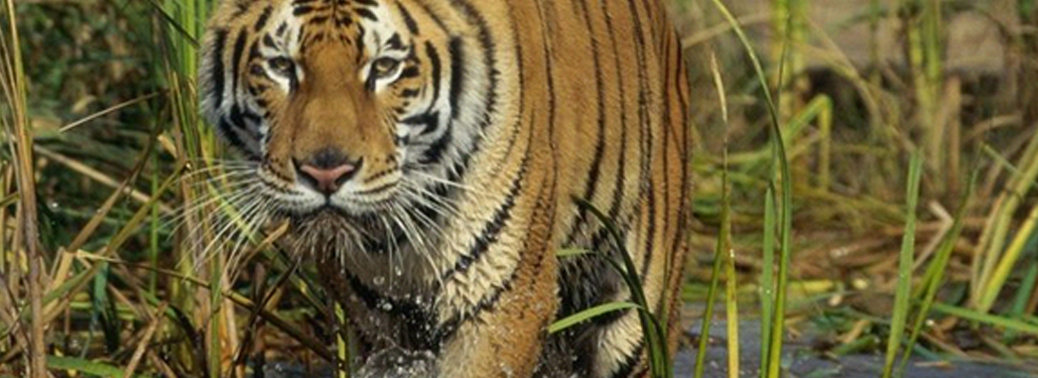RISE OF TIGER POPULATION IN SUNDARBANS
08, May 2020

Prelims level : Bio Diversity & Its Threat
Mains level : GS-III Conservation, environmental pollution and degradation, environmental Impact Assessment.
Why in News?
- According to the West Bengal Forest Department, the latest estimation of tiger numbers in the Indian Sundarbans indicate an increase in the population of big cats, that is the count for the year 2019-20 rose to 96, from 88 in 2018-19.
About the News:
- The estimation revealed that of the 96 tigers, 23 were identified as male and 43 as female, while the sex of 30 big cats could not be determined.
- The survey also revealed the presence of 11 tiger cubs.
- The estimation exercise was carried out in two phases: the first period commencing on December 16 and ending on January 13, and the second phase starting on January 22 and ending on February 19.
- For the first period, a total of 1,156 Cuddeback camera traps (578 pairs) were installed in the Sundarbans Tiger Reserve and during the second period, 272 camera traps (136 pairs) were installed in the 24 Parganas (South) Division.
About Sundarbans:
- The Sundarbans mangrove forest, one of the largest such forests in the world, lies across India and Bangladesh on the delta of the Ganges, Brahmaputra and Meghna rivers on the Bay of Bengal.
- It is adjacent to the border of India’s Sundarbans World Heritage site inscribed in 1987.
- The Indian Sundarbans, considered to be an area south of the Dampier Hodges line, is spread over 9,630 sq. km., of which the mangrove forests are spread over 4,263 sq. km.
- The site is intersected by a complex network of tidal waterways, mudflats and small islands of salt-tolerant mangrove forests, and presents an excellent example of ongoing ecological processes.
- The area is known for its wide range of fauna, including 260 bird species, the Bengal tiger and other threatened species such as the estuarine crocodile and the Indian python.
- It is home to many rare and globally threatened wildlife species such as the estuarine crocodile, Royal Bengal Tiger, Water monitor lizard, Gangetic dolphin, and olive ridley turtles.
- It is home to one of the noted tiger reserves in India and also the only mangrove forest in the world inhabited by tigers.
- A satellite image from the Indian Space Research Organisation pointed to a loss of 3.71% mangrove and non-mangrove forest cover along with massive erosion of the archipelago’s landmass.
- The analysis, based on satellite data of February 2003 and February 2014, shows that while a 9,990-hectare landmass has been eroded, there has been an accretion (addition) of 216-hectare landmass in the Sundarbans during the period.

Reason for the Increase:
- Discovery India and World Wide Fund (WWF) India have partnered with the Government of West Bengal and local communities in the Sundarban last year to help save the world’s only mangrove tiger habitat.
- The project used technology to solve several of the issues faced in the region which included building datasets on impacts of climate change on estuarine ecosystem.
- The initiative focused on enhancing farmland productivity through low-cost measures and adjusting crop calendars to deal with climate change.
- The initiative also included work towards securing habitats for tigers and Prey Species.
- The project at Sundarbans was part of a global movement, Project CAT (Conserving Acres for Tigers), aimed at building healthy habitats for Tigers by conserving six million acres of protected land across four countries.
About Project CAT (Conserving Acres for Tigers):
- Discovery Communications is working with World Wildlife Fund and others to support a worldwide effort to double the number of tigers in the wild by 2022.
- It is a mission to ensure a future for tigers and other endangered wildlife by conserving nearly a million acres of protected land on the border of India and Bhutan.
- Tigers face multiple threats from poaching, habitat loss and fragmentation, conflict with humans and overhunting of their prey species.
Why Tiger Conservation is Essential?
- Tigers are at the top of the food chain and are sometimes referred to as “umbrella species” that is their Conservation also Conserves many other species in the same area.
- The Tiger estimation exercise that includes habitat assessment and prey estimation reflects the success or failure of Tiger Conservation Efforts.
- More than 80% of the world’s wild tigers are in India, and it’s crucial to keep track of their numbers.














